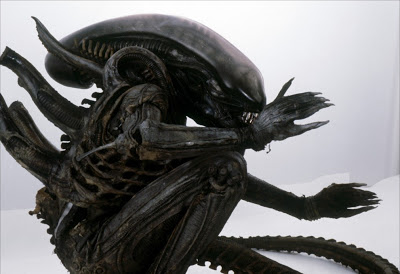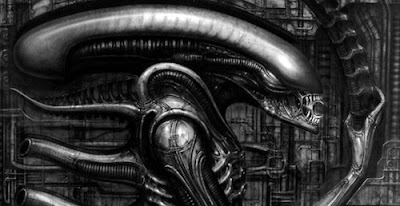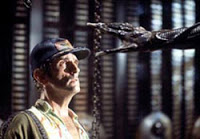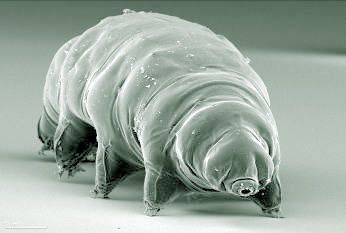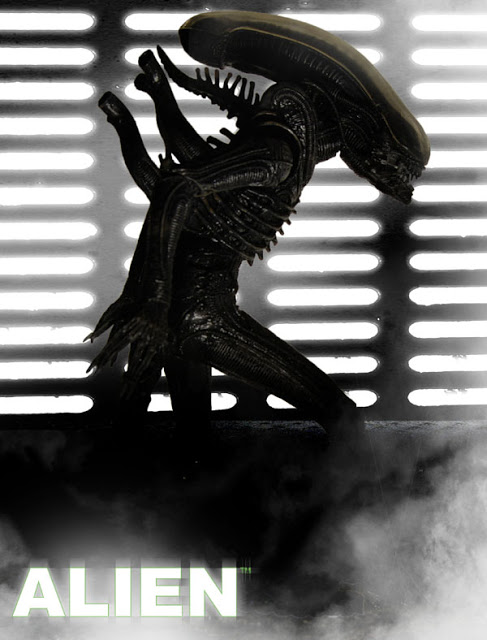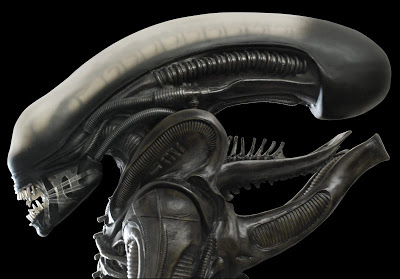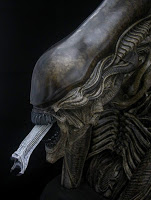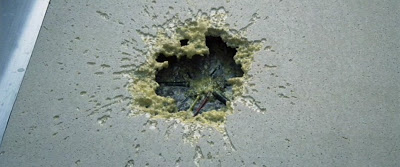
If there is one thing good monsters do, it makes a franchise. If defies death and comes back for one more thrust to the jugular.
Sometimes it’s good, sometimes it’s bad.
No other monster has come close to Godzilla’s 28 movie legacy (+1 American adaptation no one wants to talk about).
Still, Alien doesn’t need many films to become an icon of horror and it is one of the only ones to be treated as an animal rather than a singular entity and survive in mainstream media. Usually, a monster succeeds because it’s an individual with a lot of character.
Here, the monster manages to retain that character while staring with the knowledge that the horror of the first film was done by one of many.
The only way to deal with the symbolism of the Alien is to deal with it bluntly. The Alien is a rapist from the moment is appears. The way it reproduces itself ends up as a sort of super rape because it includes the absolute worst case scenario for a rape victim (becoming pregnant by the attacker and dying in childbirth) on any gender possible.
The monster itself also walks around with a giant phallic symbol for its head in its adult form. That’s rather obvious.
The tongue attack it became famous for only adds to the Freudian fun.
And the less said about what the bottom of the “Face Hugger” the better.
Along with that horror there is also the primordial fear of predation. The monster hunts like a leopard, staling humans from the darkness where we know it is there, but cannot see it. These creatures also have the leopard-like habit of leaping down to pounce on victims or to reach down and grasp them from above. This strikes deep at human primal fears, given that leopards and other big cats have been killing primates like us in that exact same manner for at least 3 million years.
Then there is the fact that it as an alien is the ultimate other. The original script called for an insect-like creature, but the Geiger designed bio-mechanical bug-skeleton we know today exemplifies how much of an unknown it is. Besides being an alien, it bears no resemblance to anything on earth except in vague or superficial manners.
The beast has seven fingers in its original appearance. This was later cut down to ease suit creation.
Then there is another aspect of how it hunts.
Aside from lurking in darkness and in tunnels where it cannot be seen, it attacks its prey by utilizing three dimensional thinking, attacking its hapless victims from above or below.
Humans don’t normally think in those terms, its why most science fiction space ship battles resemble either World War II Naval battles or Master In Commander style ships of the line rather than The Hunt for Red October.
We evolved on the plains of Africa who once climbed trees to escape predators—we are not used to dealing with death from above that often.
There weren’t enough Giant Eagles in the past to instill any fears like that.
Biology
Oh boy.
This is gonna smart.
To keep it simple, this will primarily take into account the first two films. Also known as “The best of the bunch.” There’s a lot of other stuff out there (toys, comics, novels, etc.), so let’s just focus on what got the ball rolling. There are a few things that the expanded media and further films do which are interesting, so I’ll mention them when needed. However, they also contain some damn stupid ideas.
For the sake of sanity, we’ll skip over those.
 |
| Egg found on the surface of LV-426 |
Though I will say that the idea of parasitoid organisms incorporating aspects of the host’s biology into their adult forms is beyond silly, though it does help solidify the whole “Rape Baby” theme the Alien goes for.
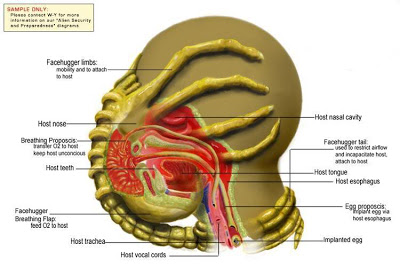 |
| Facehugger symbiology |
To start with, the Aliens are parasitoids and appear to have a hive-based structure. This is a counterintuitive combination. There are wasps that are parasitoids, but none have hives to work from. The hives of carnivorous insects tend to use their Larva to create the adult’s food (the adults feed on substances regurgitated by the larva after they are given meat). Parasitoid mothers are usually out for themselves and target a specific variety of species.
Wherever these beasts hail from, humanoids must be on the menu.
Covered in an exoskeleton, but also having an endoskeleton (as shown in Predator 2), they can apparently survive for a short period of time in the vacuum of space.
This is not that unheard of, though. The Tardigrades or “Water Bears” can withstand a lot when they dehydrate themselves and survive a whole lot.
It is likely that the original creature was attempting to snuggle up and latch on to the ship (unfortunately doing so in the rocket engines exhaust plume) in preparation for such a dehydration maneuver. The outer shell and lack of liquids would spare the creature a horrific death in space and let it travel in the vacuum for years, perhaps.
Enough to return to a planet below, but little else. Space is huge. Really huge.
These organisms appear to have a cast system as well. Cast systems are found in several types of insects, but not especially with the wasps they are largely based on. Here, instead, they draw from ants: having workers, soldiers and queens.
The large heads are a very interesting feature. They do not have eyes or nostrils that we can determine (though some varieties appear to have ridges along the side of the dome which could easily house chemical sensors), but the dome could still provide a sensory function. If the creature produces subsonic or ultrasonic waves from, say, the chest cavity like some kinds of cricket, the dome could be used like the melon organ in dolphins. In short, they’d sport a very sophisticated form of echo location. This trait would allow them to operate in total darkness with the ease of a bat.
The secondary mouth appears to be its primary method of killing prey in the original film, but is used much like a lion’s bite.
Only when prey is subdued and a killing blow is needed.
Otherwise, the creature delivers prey to the nesting area.
The nesting area in the hive is constructed with a hard resin which is used in a manner similar to bees wax. This substance is likely secreted from the tail or the sides (those notches have to be there for something), scraped off by the tail and then chewed up to be drooled over and onto the areas needed.
Which is exactly how bees do it. It is not a special variety of spit, but a substance they rub off their sides.
Sadly, unlike bees, the do not vomit honey. Instead, they bleed acid.
This is an interesting defense and to most, it would appear to make the creatures immune to predation.
But there are ways around it. Having a mouth lined with nonreactive substances, like the alien’s own skin (as demonstrated in Alien vs. Predator), or have chemicals in the saliva of the predator to neutralize that acid.
Or the predator is just big enough to sallow them whole and thus not expose the acid to air. Since the acid requires exposure to one of the chemicals found in the air to start its reactions, swallowing it whole would render the defense useless.
So somewhere in the alien-universe, there is a planet of Godzilla-sized ant eater, horny-toads or pangolins roaming the countryside.
Why couldn’t we get that in one of the sequels?


































































































